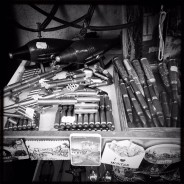
Uso de cookies
Este sitio web utiliza cookies para que usted tenga la mejor experiencia de usuario.
Si continúa navegando está dando su consentimiento para la aceptación de las mencionadas cookies y la aceptación de nuestra política de cookies.


8 June, 2015
Bullet and mortar made souvenirs spread along the window displays of the shops near Mostar Bridge. They come in shapes of tanks, helicopters and war planes. Machine gun holes still adorn some walls along Santica avenue.
With the disintegration of Yugoslavia in 1991, Milosevic had the idea of creating the “Great Serbia”, unifying all territories inhabited by Serbian citizens. The following declarations of independence by the remaining Balkan republics (Slovenia, Croatia, Bosnia, Montenegro, Macedonia and Albania) resulted in several civil wars, ethnic-religious conflicts that left thousands dead or displaced.
Bosnia houses several religions and ethnicities – Bosnian-Muslims, Orthodox –Serbians and Catholic Croats – that fought each other making an ever more tragic conflict: the Bosnian War. The destruction of symbols, the raping of women, the segregation, hatred and death were a constant. These are the sequels of one of the worst human inventions: armed conflicts.
As a consequence of all this, this Balkan country remains deeply divided. The city of Mostar is a good example, despite several international organisations and European governments have collaborated in rebuilding the old bridge (Stari Most). Erected by the Ottomans in the XVI century and destroyed by Croat tanks and artillery for being considered an insignia of the Bosnian-Muslim, today it is a symbol of closing wounds.
But, I ask myself, how is it possible to heal wounds when the Republic’s president’s post is rotated between representatives of the three ethnicities – Muslim, Croat and Serbian – that lobby towards their own interests when in power? The mosques and churches of the city compete in quantity and there is a cross on Hum hill where the Croat and Serb-Bosnian militias fired mortars against their Muslim neighbours.
I’m saddened as I walk through the city and without the fortune of understanding the language, I dedicate myself to observe. “Don’t forget 1993” proclaims a stone near the Mostar Bridge. In the cemeteries, many headstones are dated 1992 or 1993, bloody years in the conflict. I can’t stop thinking what it was like for many to run through these streets hiding from snipers just 20 years ago.
I imagine that for those living here must be hard to wake up every morning and see every day the vestiges of war. However, I think one of the gravest mistakes ever is the attempt to erase history by completely rebuilding cities without leaving any trace of what happened, taking away the potential of educating future generations.
I keep looking at the souvenirs sold around the city and I find it strange that someone can get here, walk around the city, and be interested in buying them.
I hope the future brings real reconciliation to the country; and that the souvenirs sold here would remind us not to commit the same mistakes, instead of being decorative pieces made from the banalization of ammunition.